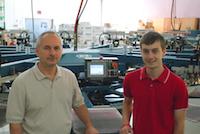by Mark Coudray
Member Academy of Screen Printing Technology
Halftone printing is all about the dots. The whole concept of printing various tones by fooling the eye is the very definition of a halftone. The tones we get are determined by the accuracy of the dots we print. Big dots mean dark tones. Small dots mean light tones. Where printers get themselves in trouble is they forget the simple fact that in order to print accurate tones or values, we have to accurately print the right size dots.
What follows is a collection of neat, quick techniques that will definitely help you to print better work, faster, easier, and more profitably. This is not a fix all, cure all program, but rather the beginning of a journey where you will ultimately be able to print any job, the first time, with great results and minimal hassle.
Only deliberate practice and experience will get you there. The goal here is to concentrate on the easy, quick methods that will go the furthest toward making your work look great with the least amount of effort.
How we See Tone and Color
It helps a great deal to visualize what you are trying to achieve. Our natural vision sees color as tone. We see light pinks, vibrant crimson reds, and deep, rich mahoganies.
By printing a deep red with dots of various sizes, we can achieve all of these colors with only one color ink. It is the same for all colors we print and combine. I f we are not accurate in printing the right size dot, the color will be wrong.
My approach is to start at the beginning of the process and work through to the end. Each step along the way has an impact, and you cannot easily build on a step that was performed poorly.
The process is sequential. Each progressive step is based on the properly prepared previous step. Another way of saying this is, if you screw-up in the beginning, it can only get worse from there.
Before you even begin the separation process, ask yourself how accurate you need to be. If pleasing color is good enough, you can easily be very successful.
Pleasing color is the best place to start. This means that the color only needs to look believable, it does not have to match.
If you need to have a perfect match of 10 different corporate logos, you are pretty much up against it. These are called memory or reference colors. The closer to a match you are, the more careful you have to be. My suggestion is to avoid this kind of work in the beginning.
A good rule of thumb is to ask yourself if the image looks hard to print. If it does, it will be.
With that out of the way, here are my Top Ten Quick Start Secrets to Better Halftone Printing. I can’t cover everything in the detail I would like here. This will get you rolling, with really good results.
Halftone Tip #1 - RGB Files
Start with good art. Use RGB files that are between 200 and 250 pixels per inch resolution at the final size of the image. Avoid JPEG files like the plague. They are corrupted and contain damaging artifacts that can cause moiré and other bad effects. To determine a damaged file, look at each channel individually at 200% – 300%. Use a plug-in like Alien Skin’s Image Doctor to fix corrupted files.
You will know if the image has JPEG damage if the edges of the detail look smoky or out of focus. You can also detect excessive pixel clumping. This makes the image look blocky. [FIGURE 1]

Below is the Green Channel, clearly showing the damaged pixel blocking and the “smoky “fringe. [FIGURE 2]

With Four passes of Alien Skin’s Image Doctor Photoshop Plug-In with Remove Artifacts set for 100, Blur Edges set to 4, and Add Grain set to 0. Notice how much improved the image is. [FIGURE 3]

To read more of this article, click here

About the Author
- Email Address mark.coudray@coudray.com
- Phone 805-541-1521
Mark is founder and President of Coudray Serigraphics, a textile screen printing company and Coudray Graphic Technologies, a digital imaging and prepress supplier to the industry. He was inducted into the Academy of Screen Printing Technology in 1989 and has served as Chairman of the ASPT twice. In addition, Mark is the recipient of 18 SGIA Golden Image Awards, 2 Swormstedt Awards, Magnus Award, and the Parmele Award (2001). He is past SGIA Chairman (2000). He has served a total of 24 years as an SGIA Director. Mark is a noted industry author with Screen Printing, Impressions, Print Wear, Images, and other trade publications with over 275 articles, columns, and technical papers as well as an industry presenter at tradeshows, conventions, and technical symposiums. He is best known for his extensive work in controlling color halftone printing, quality, and production management of the screen printing process.




